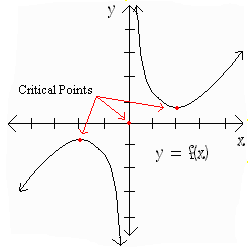 When we use calculus to describe the shape of a curve, we usually speak about
its critical points. In layman's terms, a critical point is where something
special happens to the curve - it reaches its lowest or highest value, it
changes direction or curvature, or it shoots off towards infinity. I have
come to see that large Tarot readings (and even some smaller ones) often have
similar critical points, and the cards found at those points have special
significance to the interpretation of the reading. Learning to identify and
work with these critical points is a very helpful skill when faced with a
large and confusing spread.
When we use calculus to describe the shape of a curve, we usually speak about
its critical points. In layman's terms, a critical point is where something
special happens to the curve - it reaches its lowest or highest value, it
changes direction or curvature, or it shoots off towards infinity. I have
come to see that large Tarot readings (and even some smaller ones) often have
similar critical points, and the cards found at those points have special
significance to the interpretation of the reading. Learning to identify and
work with these critical points is a very helpful skill when faced with a
large and confusing spread.Mathematicians find critical points of a curve by examining its derivatives. These tell us how the curve looks - whether it points up or down, whether it is a steep or a shallow curve. In a Tarot reading the images themselves let us see what cards are particularly important. For example, consider the King of Wands in the Rider-Waite-Smith deck. His gaze is fixed on something just outside of our view, past the left boundary of the card. Just what do you suppose he's looking at? When he turns up in a reading, there's a very good chance that the card to his left (if there is such a card) is in fact one of the reading's critical points.
Many cards in the deck can serve as similar indicators. The easiest ones to spot are usually the Swords cards, because the Swords are almost like arrows, showing you which way to go to find the critical points. But other cards have natural arrows or directions built into the image, like the Magician, who is pointing with his arms. Some cards point to multiple points at the same time, like the Two of Swords or Four of Swords, which draw attention to two potential critical points. I say "potential" because not every point that is indicated in this way is a critical point. Usually you'll find that a true critical point has at least two different cards pointing to it.
As an example, take a Rider-Waite deck (or one of its close variants like the Universal Waite or Albano Waite) and lay out the following cards in two rows of three. In the upper row, from left to right, the Nine of Pentacles, the Seven of Swords and the Tower. In the lower row, place the Star, the King of Wands and the Nine of Cups. (This is one of those techniques that you can't always visualize, so I really encourage you to get a deck and lay these cards out before proceeding.) Since this spread has been deliberately created you should suspect that it has a critical point, and indeed it does. Look at the spread and try to see where your eyes are being directed by the images.
The critical point in this case is the Star card in the lower left corner. First of all, the King of Wands is staring right at it. Second, the Swords being carried by the man on the Seven of Swords all slope downwards, thus pointing to the Star. And there is a third directional indicator in this reading. Can you spot it? Notice the arrow-shaped lightning bolt on the Tower. It points down and to the left, almost directly at the Star card. The Nine of Pentacles and Cups in this reading have no useful directional information and are not critical points. This is not to say that they are unimportant, simply that they are not what we are looking for right now.
So, now that we know how to find them, what are critical points good for? Their major importance to readers is that they provide a central point to a large reading - a place to start from, and a place to come back to when the apparent supply of information is exhausted. With spreads the size of the Celtic Cross it is too easy to simply jump from card to card, never making any kind of cohesive interpretation. The critical point in such a spread is a focus that all of the cards can be related to, and it serves as the main link in a chain of details that make up the interpretation as a whole.
In fact, a critical point (or points - like a curve, a reading may have one critical point, many, or none at all) in a spread should almost always be a major influence in your interpretation. It often represents the major issue that must be faced or the best possible outcome. You can also use it as a quick answer to the original question, which the other cards expound upon. If you use dignities, the critical point can show a "global dignity" that is then applied to all cards in the reading. The ways to use the critical point are many, and you should trust your intuition to guide you. Making use of the critical point will add lots of depth to your readings.
Copyright 2001 James Rioux